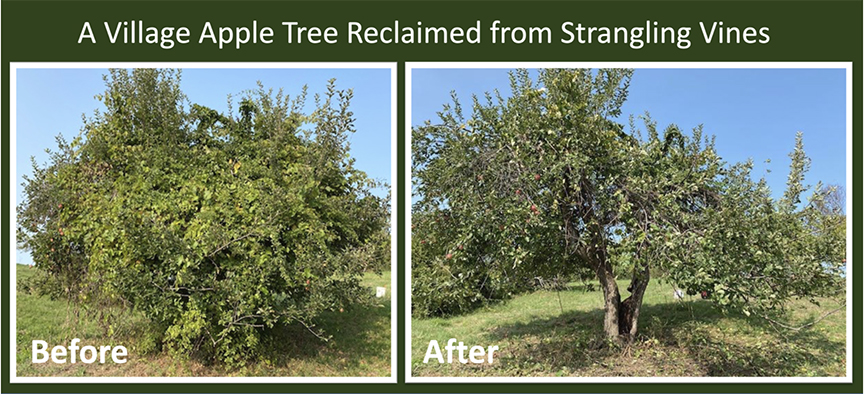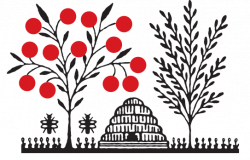Garden Committee and Volunteers Revitalize and Reclaim

CSV garden committee and volunteers work to revitalize history-rich Village lands, reclaim fruit trees from strangling invasive vines
By Jennifer Solms and Mary Lou Dopart, Natural Resources Stewards 2019
Anyone approaching the rolling hills of the Canterbury Shaker Village (CSV) anticipates scenic walks through the Village, its historic orchards, forest trails, and open spaces. Ensuring the bucolic year-round scenery and health of the Shaker Village’s natural resources requires attention from many staff, volunteers and specialists.
Planning
Recently, a volunteer ad hoc Lands and Gardens Committee has been meeting at the Village to develop long-range plans for the property. The committee includes an orchardist, landscape and garden experts, historians, and UNH Cooperative Extension staff and volunteers who are working to develop best practices for preserving, maintaining, and revitalizing the property. The Village includes almost 700 acres of forests, pastures, orchards, ponds, hiking trails, 25 historic buildings and many original building foundations that document the full extent of the working Shaker Village.
In October, the Village Committee set near-term priorities for the Village. These included inspecting and mapping the hiking trail system, establishing a plan to improve the health of the orchards, and preparing the perennial gardens for the cold winter months.
Learning
A tour of the Village orchards was part of the information-gathering process. Guest speakers on the tour included John Haberle, a CSV volunteer orchardist, and Kevin Bragg, a former CSV garden coordinator. The purpose of the tour was to learn about the history of the orchards and their importance to the Village and to discuss the future of the orchards.
The tour was a unique opportunity to learn about how the orchards contributed to the success of the Shakers and influenced the development of the land that once grew thousands of fruiting trees and shrubs during the Shakers’ peak years. Row upon row of productive trees thrived on the rolling hillsides of the Village and were carefully catalogued by the Shakers.
Orchardist John Haberle pointed out how to identify fire blight in fruit trees and why it is important to address it quickly. He also discussed how the Shakers diversified the fruit-tree population to ensure consistent harvests month-to-month throughout the season. Former CSV garden coordinator Kevin Bragg added stories about how the Shakers planned the locations of the orchards on the hillsides to protect from late spring frosts and damaging winds. He also reminded the Committee about the importance of carrying on the practice of planting the right tree in the right place for the right purpose.
Haberle and Bragg also discussed the details about the Shakers’ search for optimal varietal strains to survive cold New Hampshire winters. As an example, they explained that Shakers researched apple-orchard growth in a like climate – Russia. Based on their findings, the Shakers imported various varietals from Russia including ‘Yellow Transparent’ in the early 1900s. John Haberle pointed to a row of mature apple trees full of ripe red apples and commented that the trees are the original strain imported from Russia and represent the first introduction of the Delicious varietal to the United States.
Over the years, the Shakers expanded the orchards and fostered prolific growth of the trees. The Shakers donated bushels of apples to the surrounding villages, shared the bounty with the needy, and produced food and cider for the Shaker Community. During years with abundant harvests, the resourceful Shakers processed and canned apple sauce that was sold coast to coast.
Revitalizing
Haberle explained that apple trees in the orchards require attention. They are victims of invasive plants such as multiflora rosa, Asian bittersweet, and poison ivy. The aggressive climbing vines strangle trunks and branches as they climb to tree crowns blocking sunlight from reaching the tree.
Natural Resources Stewards (NRS) have been volunteering this fall to reclaim the trees from these invasive plants. The Stewards meet weekly under the direction of Mike Barwell, Steward and Master Gardener, to work on trees requiring immediate attention. Their work is beginning to transform the most stressed historic apple trees back into healthy, thriving trees by removing the invasive plants from trunk to tree crowns. If you are a frequent visitor to the CSV, you may see the Stewards working in the orchards or along trails in the forests.
The efforts to support the orchards, prep the perennial gardens for winter, and map the Village hiking trails will continue with the help of many volunteers. The NRS volunteers give back to Canterbury Shaker Village honoring the land, plants, and wildlife and the Shakers who were the Stewards for over 200 years. Today’s visitors can see at every turn how deeply attuned the Shakers were to the importance or fostering growth of native species and enhancing biodiversity. The Natural Resources Stewards help to promote the Shakers’ spirit of conservation in this century.




